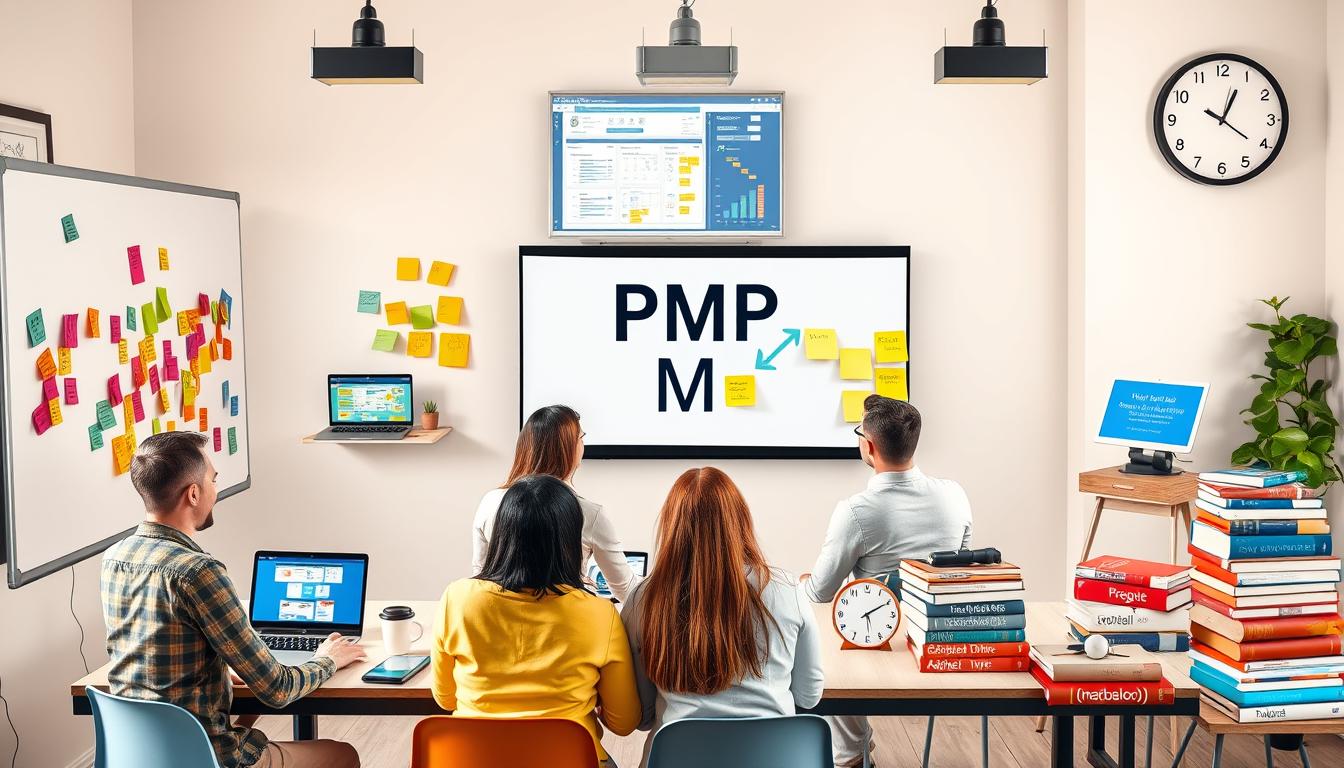Studying for the Project Management Professional (PMP) exam can be a daunting task, especially when it comes to memorizing all the different processes and their inputs, tools & techniques, and outputs. This is where mnemonic devices come in handy. Mnemonic devices are memory aids that help us remember information in an easier and more efficient way than rote memorization.
Why mnemonic devices are important for memorizing PMP processes
Using mnemonic devices can be a powerful tool for PMP exam preparation. Since the exam covers a vast amount of material, it is easy to get lost in the details. Mnemonics help us to simplify and group the information in a way that makes it easier to retain. They also allow us to recall information quickly and efficiently, which is essential for completing the exam within the allotted time.
Another benefit of using mnemonic devices is that they can help us to remember complex processes and their order. For example, the PMP exam requires knowledge of the five process groups: initiating, planning, executing, monitoring and controlling, and closing. Mnemonics can be used to remember the order of these groups, such as “I Prefer Eating M&Ms Constantly” or “I Plan Every Meeting Carefully”. This can be especially helpful when trying to recall information under pressure during the exam.
Furthermore, mnemonic devices can be tailored to individual learning styles. Some people may find it helpful to use visual aids, such as diagrams or acronyms, while others may prefer to use rhymes or songs. By creating personalized mnemonic devices, individuals can enhance their ability to remember and recall information, leading to greater success on the PMP exam.
Understanding the benefits of using mnemonic devices for PMP exam preparation
One of the significant benefits of using mnemonic devices is that they help us to visualize the information. When we create a visual image to represent each process and its associated inputs, tools & techniques, and outputs, we are more likely to remember the information. This is because our brain is better at recalling images than words or random facts.
Another benefit of using mnemonic devices is that they can be tailored to suit our individual learning styles. For example, if you are a visual learner, you may want to create a series of images or diagrams to represent each process. If you are an auditory learner, you may want to create a song or a rhyme that incorporates all the information.
Additionally, using mnemonic devices can help to reduce stress and anxiety when preparing for the PMP exam. By breaking down complex information into smaller, more manageable pieces, we can feel more confident in our ability to retain and recall the information. This can lead to a more relaxed and focused mindset when studying for the exam.
Furthermore, mnemonic devices can be a fun and creative way to engage with the material. Instead of simply memorizing dry facts and figures, we can use our imagination and creativity to come up with unique and memorable ways to remember the information. This can make the studying process more enjoyable and less tedious.
The science behind using mnemonics for memory retention
There is a scientific basis for using mnemonic devices. The human brain is wired for pattern recognition and association. When we see or hear something familiar, our brain automatically links it to other related information. This linking process creates a network of associations that makes it easier to retrieve information from memory.
Using mnemonic devices taps into this natural process by creating associations between the information we want to remember and something that is already familiar to us. By doing so, we help our brain to create a network of interconnected associations that makes it easier to recall the information.
Research has shown that using mnemonics can significantly improve memory retention. In one study, participants who used mnemonic techniques were able to recall 88% of the information they learned, compared to only 28% for those who did not use mnemonics.
Furthermore, mnemonic devices can be particularly effective for remembering lists or sequences of information. By creating a memorable phrase or image that links each item in the list, we can more easily recall the entire sequence in order.
Step-by-step guide to creating effective mnemonic devices for PMP processes
The following is a step-by-step guide to creating effective mnemonic devices for PMP processes:
- Identify the process: Identify the process that you want to remember, along with its associated inputs, tools & techniques, and outputs.
- Create an image: Create a visual image to represent the process and its associated inputs, tools & techniques, and outputs. The image should be memorable and easy to recall.
- Create an association: Create an association between the image and the process. The association should be logical and easy to remember.
- Link the information: Link the information to something that is already familiar to you. This will help to create a network of associations in your brain that makes it easier to retrieve the information.
- Practice: Practice recalling the information using your mnemonic device until you can easily recall it without much effort.
Using mnemonic devices can be an effective way to remember complex information, such as the PMP processes. However, it is important to note that not all mnemonic devices work for everyone. It is important to experiment with different techniques to find the one that works best for you.
Additionally, it is important to review and update your mnemonic devices regularly. As you gain more experience and knowledge, your mnemonic devices may need to be adjusted to reflect new information. Regularly reviewing and updating your mnemonic devices can help ensure that they remain effective over time.
Examples of effective mnemonic devices for memorizing PMP processes
Here are some examples of effective mnemonic devices for memorizing PMP processes:
- Initiating: My Aunt’s Cat Sheds Fur (M.A.C.S.F.)
- Planning: So Many Expectations Create Variability In Time (S.M.E.C.V.I.T.)
- Executing: Even As Extremely Engaging Routines Deliver Great Results (E.A.E.E.R.D.G.R.)
- Monitoring and Controlling: Chris Accepts Some All-Star Lollipops With Great Pride (C.A.S.A.L.W.G.P.)
- Closing: Praise Everyone To A Happy Conclusion (P.E.T.A.H.C.)
It is important to note that mnemonic devices are not a one-size-fits-all solution for memorizing PMP processes. Different people may find different devices more effective, and it may take some trial and error to find the right one for you.
Additionally, while mnemonic devices can be helpful for memorization, it is important to also understand the underlying concepts and processes. Mnemonic devices should be used as a supplement to studying and understanding the material, not as a replacement for it.
Tips and tricks for making your mnemonic devices more memorable
Here are some tips and tricks for making your mnemonic devices more memorable:
- Use vivid imagery: The more vivid and detailed your imagery, the more memorable it will be.
- Integrate humor: Humor can be a powerful tool for making information more memorable.
- Use rhyme: Rhyme can be a useful tool for making information more memorable.
- Repetition: Repetition can help to reinforce the information in your brain.
Another tip for making your mnemonic devices more memorable is to use personal connections. Try to relate the information you are trying to remember to something personal or meaningful to you. This will help to create a stronger connection in your brain and make the information easier to recall.
Additionally, using acronyms or acrostics can be a helpful tool for remembering lists or sequences. Create a word or phrase using the first letter of each item in the list, or use the first letter of each word in a sentence to create a memorable phrase.
How to use visual aids and association techniques to enhance your mnemonic devices
Visual aids and association techniques can be powerful tools for enhancing your mnemonic devices. For example, you can use mind maps or diagrams to help visualize the information. You can also use association techniques like acronyms, acrostics, or the method of loci to help create associations between the information and something that is familiar to you.
Another effective visual aid is the use of color coding. Assigning different colors to different pieces of information can help you remember them better. For instance, you can use red for important dates, blue for names, and green for definitions. This way, when you recall the information, you can visualize the colors and remember the associated information.
Association techniques can also be combined with visual aids to create even stronger mnemonic devices. For example, you can create a mind map and use acronyms or acrostics to label each branch. This way, you are not only visualizing the information, but also creating associations between the information and the acronym or acrostic.
Common mistakes to avoid when creating and using mnemonic devices for PMP exam preparation
Here are some common mistakes to avoid when creating and using mnemonic devices:
- Creating overly complex associations: Keep the associations simple and easy to remember.
- Creating associations that are not logical: Associations should make sense logically.
- Not practicing: Practice is vital for ensuring that the information is entrenched in your memory.
Another common mistake to avoid when creating and using mnemonic devices is not personalizing the associations. Mnemonic devices work best when they are tailored to your own experiences and interests. For example, if you are trying to remember the order of the planets, you could create an association using the first letter of each planet’s name, but it may be more effective to create an association based on a personal memory, such as “My very eager mother just served us nachos” (Mercury, Venus, Earth, Mars, Jupiter, Saturn, Uranus, Neptune).
It is also important to avoid relying solely on mnemonic devices. While they can be helpful for memorization, they should not be the only method used for studying. It is important to also understand the concepts and principles being tested on the PMP exam, and to practice applying them in real-world scenarios.
Importance of practicing with your mnemonic devices before the PMP exam
Practicing with your mnemonic devices before the PMP exam is crucial for success. The more you practice, the more comfortable and confident you will be when the time comes to take the test. Use your mnemonic devices to review the information regularly and try to recall the information without looking at your notes.
Additionally, practicing with your mnemonic devices can also help you identify any gaps in your knowledge. As you review the information, you may realize that there are certain areas where you need to focus more attention. This can help you adjust your study plan and ensure that you are fully prepared for the exam.
How to maintain and revise your mnemonic devices as you progress in your PMP studies
As you progress in your PMP studies, you may find that your mnemonic devices need to be revised or updated. This is entirely normal, and it’s essential to be flexible and adaptable. Keep track of what works and what doesn’t and make changes as necessary.
One way to maintain and revise your mnemonic devices is to regularly review and test them. Set aside time each week to go over your devices and see if they are still effective. If you find that a particular device is no longer working, try to identify why and make the necessary changes.
Another helpful tip is to create new mnemonic devices as you encounter new information. This can help you remember new concepts and keep your study materials organized. Don’t be afraid to get creative and come up with unique devices that work for you.
Resources for finding additional help with creating effective mnemonic devices for PMP processes
If you need additional help with creating effective mnemonic devices for PMP processes, there are several resources available. There are numerous online forums and study groups where you can collaborate with other PMP candidates and share mnemonic devices. There are also many PMP study guides and books that offer tips and suggestions for creating effective mnemonic devices.
Conclusion
Mnemonic devices can be a powerful tool for memorizing the complex processes and concepts required for the PMP exam. They allow us to simplify information, create visual representations, and make associations that help us recall the material more efficiently. By following the steps outlined above and using the tips and tricks provided, you can create effective mnemonic devices that will help you succeed on the PMP exam.




